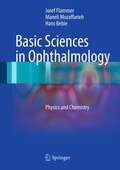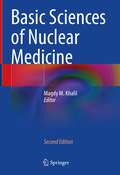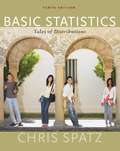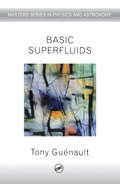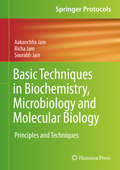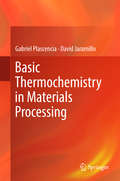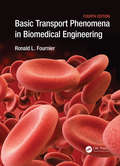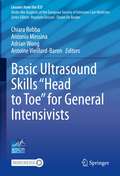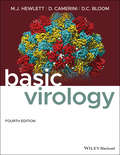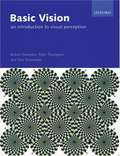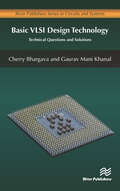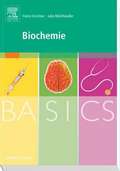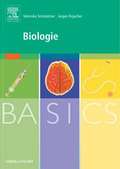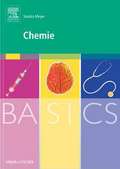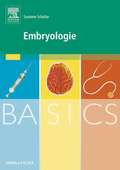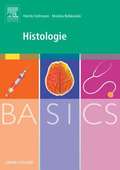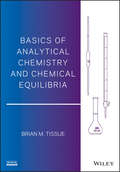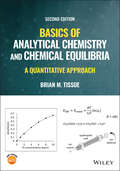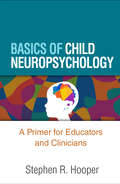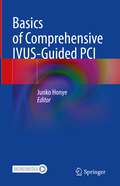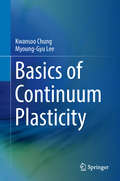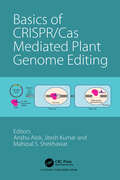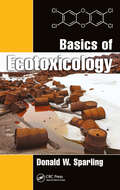- Table View
- List View
Basic Science Part 2 class 8 - S.C.E.R.T. - Kerala Board
by State Council of Educational Research and TrainingBasic Science Part 2 text book for 8th standard from State Council of Educational Research and Training (S.C.E.R.T.) Kerala in English.
Basic Sciences in Ophthalmology: Physics and Chemistry
by Hans Bebie Josef Flammer Maneli MozaffariehBasic Sciences in Ophthalmology aims to link clinical ophthalmology directly to its basic science roots. This first volume describes the physics and chemistry required for a sound understanding of modern ophthalmology. The book opens with an extensive discussion of the interaction of light with matter and the way in which light is used in ophthalmic examinations and treatments. After describing traditional methods of imaging, particular emphasis is placed on modern instrumentation such as OCT. The interaction between light and tissues in different types of laser treatment is also addressed. The chemistry section focuses on compounds particularly relevant to the eye, such as oxygen and water. The origin and consequences of oxidative stress are reviewed, and the physical behavior of chemical compounds in the eye is explained. Understanding is facilitated through the use of many examples taken from the field of ophthalmology. The text is complemented by about 450 figures.
Basic Sciences of Nuclear Medicine
by Magdy M. KhalilThis book provides comprehensive and detailed information on the scientific bases of nuclear medicine, addressing a wide variety of topics and explaining the concepts that underlie many of the investigations and procedures performed in the field. The book is divided into six sections that cover the physics and chemistry of nuclear medicine besides associated quality assurance/quality control procedures; dosimetry and radiation biology; SPECT and PET imaging instrumentation plus CT imaging technology in hybrid modalities; data analysis including image processing, reconstruction, radiomics, image degrading correction techniques, along with image quantitation and kinetic modeling. Within these sections, particular attention is paid to recent developments and the advances in knowledge that have taken place since release of the first edition in 2011. Several entirely new chapters have been included and the remaining chapters, thoroughly updated.Innovations in the ever-expanding field of nuclear medicine are predominantly due to integration of the basic sciences with complex technological advances. This excellently illustrated book on the subject will be of interest to not only nuclear medicine physicists and physicians but also clinical scientists, radiologists, radiopharmacists, medical students and technologists.
Basic Semiconductor Physics (Graduate Texts in Physics)
by Chihiro HamaguchiThis textbook presents a detailed description of basic semiconductor physics, covering a wide range of important phenomena in semiconductors, from simple to advanced. It introduces and explains four different methods of energy band calculations in the full band region and covers fundamental topics such as the effective mass approximation and electron motion in a periodic potential, the Boltzmann transport equation, and deformation potentials used for the analysis of transport properties. The text also examines experimental and theoretical analyses of cyclotron resonance in detail and reviews essential optical and transport properties, while covering optical transitions, electron–phonon interaction, and electron mobility. It presents numerical calculations of scattering rate, relaxation time, and mobility for typical semiconductors with bulk, quantum well and HEMT structures including wideband gap materials such as GaN and SiC in addition to IV and III-V semiconductors.The updated fourth edition includes coverage of new topics such as surface-modulated superlattices, Wannier–Stark effect, Bloch oscillation, wide band gap semiconductors, and photonic crystals. Featuring full-color diagrams calculated with updated physical parameters, as well as chapter-end problems and solutions, this tried and tested textbook on the basics of semiconductors physics is the cornerstone to any graduate or upper-level undergraduate course on the subject.
Basic Statistics: Tales Of Distributions
by Chris SpatzLearn statistical reasoning and problem solving from a best-selling author who uses a wealth of examples from the social and behavioral sciences,, education,, nursing/allied health, and business fields--as well as examples from everyday life-to help you learn and understand. Praised for his clear explanations, Spatz shows you how to start with a data set, identify the questions it poses, determine and carry out statistical procedures, and using plain English, tell the story the data reveal.
Basic Superfluids
by Tony GuenaultSuperfluidity is the jewel in the crown of low temperature physics. When temperatures are low enough, every substance in thermal equilibrium must become ordered. Since some materials remain fluid to the lowest temperatures, it is a fascinating question as to how this ordering can take place. One possibility is the formation of a superfluid state, a
Basic Techniques in Biochemistry, Microbiology and Molecular Biology: Principles and Techniques (Springer Protocols Handbooks)
by Aakanchha Jain Richa Jain Sourabh JainThis book presents key methodologies, tools and databases for biochemistry, microbiology and molecular biology in simple and straightforward language. Covering all aspects related to experimental principles and procedures, the protocols included here are brief and clearly defined, and include essential precautions to be taken while conducting experiments. The book is divided into two major sections: one on constructing, working with, and standard operating procedures for laboratory instruments; and one on practical procedures used in molecular biology, microbiology and biochemical analysis experiments, which are described in full. Each chapter describes both the basic theory and relevant practical details for a given experiment, and helps readers recognize both the experiment’s potential and limitations. Intended as an intensive introduction to the various tools used in molecular biology, the book covers all basic methods and equipment, including cloning, PCR, spectrophotometers, ELISA readers, sonicators, etc. As such, it offers a valuable asset for final year undergraduate (especially project) students, graduate research students, research scientists and technicians who wish to understand and employ new techniques in the field of biotechnology.
Basic Thermochemistry in Materials Processing
by David Jaramillo Gabriel PlascenciaThis book provides the reader with some thermochemistry notes. The intention is to provide a simple, easy to understand text which serves as a complimentary material to more complex books. It also provide students and those beginning in the field with several application examples used in different areas of materials processing. The book presents fully solved problems, some quite often found in major metallurgical operations.
Basic Transport Phenomena in Biomedical Engineering (Fourth Edition)
by Ronald L. FournierThis will be a substantial revision of a good selling text for upper division/first graduate courses in biomedical transport phenomena, offered in many departments of biomedical and chemical engineering. Each chapter will be updated accordingly, with new problems and examples incorporated where appropriate. A particular emphasis will be on new information related to tissue engineering and organ regeneration. A key new feature will be the inclusion of complete solutions within the body of the text, rather than in a separate solutions manual. Also, Matlab will be incorporated for the first time with this Fourth Edition.
Basic Ultrasound Skills “Head to Toe” for General Intensivists (Lessons from the ICU)
by Chiara Robba Antonio Messina Adrian Wong Antoine Vieillard-BaronThe aim of this book, part of the European Society of Intensive Care Medicine (ESICM) textbook series, is to educate and train practitioners in the safe and competent use of diagnostic ultrasound imaging in the visualization and interpretation of different conditions. Specifically, the program will train practitioners in the safe and accurate acquisition of ultrasound images in the examination and monitoring of patients in intensive care settings. The readers will be able to obtain knowledge on the use of ultrasound in a safe and effective manner and to learn how ultrasound examination can be used to optimize clinical management of patients. The chapters include ultrasound physics, ultrasound examination technique, optimization of the image, bedside ultrasound diagnosis of different diseases. Different domains will be addressed from the evaluation of different organs such as the heart, the lung, the abdomen, vessels and brain, focusing on the basic skills required to an intensivists working in the general Intensive Care Unit settings. The book - richly illustrated and with electronic supplementary contributions - is intended for anaesthetists and intensivists with basic knowledge of ultrasound physics and practical experience of ultrasound.
Basic Virology
by Martinez J. Hewlett David Camerini David C. BloomThe foundational textbook on the study of virology Basic Virology, 4th Edition cements this series’ position as the leading introductory virology textbook in the world. It’s easily read style, outstanding figures, and comprehensive coverage of fundamental topics in virology all account for its immense popularity. This undergraduate-accessible book covers all the foundational topics in virology, including: The basics of virology Virological techniques Molecular biology Pathogenesis of human viral disease The 4th edition includes new information on the SARS, MERS and COVID-19 coronaviruses, hepatitis C virus, influenza virus, as well as HIV and Ebola. New virological techniques including bioinformatics and advances in viral therapies for human disease are also explored in-depth. The book also includes entirely new sections on metapneumoviruses, dengue virus, and the chikungunya virus.
Basic Vision: An Introduction to Visual Perception
by Robert Snowden Peter Thompson Tom TrosciankoBasic Vision: An Introduction to Visual Perception demystifies the processes through which the brain "sees." It leads us through the various elements that come together in our perception of the world around us: size, color, motion, and three-dimensional space. The book illustrates the intricacy of the visual system, discussing its development during infancy, and reveals how the brain can get it wrong.
Basic VLSI Design Technology: Technical Questions and Solutions (River Publishers Series In Circuits And Systems Ser.)
by Cherry Bhargava Gaurav Mani KhanalThe current cutting-edge VLSI circuit design technologies provide end-users with many applications, increased processing power and improved cost effectiveness. This trend is accelerating, with significant implications on future VLSI and systems design. VLSI design engineers are always in demand for front-end and back-end design applications.The book aims to give future and current VSLI design engineers a robust understanding of the underlying principles of the subject. It not only focuses on circuit design processes obeying VLSI rules but also on technological aspects of fabrication. The Hardware Description Language (HDL) Verilog is explained along with its modelling style. The book also covers CMOS design from the digital systems level to the circuit level. The book clearly explains fundamental principles and is a guide to good design practices.The book is intended as a reference book for senior undergraduate, first-year post graduate students, researchers as well as academicians in VLSI design, electronics & electrical engineering and materials science. The basics and applications of VLSI design from digital system design to IC fabrication and FPGA Prototyping are each covered in a comprehensive manner. At the end of each unit is a section with technical questions including solutions which will serve as an excellent teaching aid to all readers.Technical topics discussed in the book include: • Digital System Design• Design flow for IC fabrication and FPGA based prototyping • Verilog HDL• IC Fabrication Technology• CMOS VLSI Design• Miscellaneous (It covers basics of Electronics, and Reconfigurable computing, PLDs, Latest technology etc.).
BASICS Biochemie, German Edition
by Hanni Kirchner Julia MühlhäußerSpeziell für Medizinstudenten gemacht: der perfekte Überblick über die gesamte Biochemie</b<! Von A wie Aminosäuren bis Z wie Zellstoffwechsel. <P><P> <ul> <li>Gut: kompakter Überblick über die Biochemie</li> <li>Besser: mit vielen Klinikkästen und Versuchsbeschreibungen</li> <li>Basics: jedes Thema in kleinen Häppchen auf je einer Doppelseite. Schön in Farbe, prima zu lesen und mit vielen Versteh-Bildern im typischen "Basics"-Stil</li> </ul> <P><P>Das Beste: geschrieben von einem starken Team –Studenten und erfahrenen Ärzten – die wirklich Bescheid wissen. So wird Biochemie verständlich, ohne zu sehr ins Detail zu gehen. Ideal zum Einarbeiten ins Thema! Das bieten Ihnen die BASICS: <ul> <li>das Wesentliche zum Thema in leicht verständlicher Form</li> <li>schnell fit für Praktika, Famulaturen und bed-side-teaching-Kurse</li> <li>fächerübergreifendes Wissen - ideal zum Lernen nach der neuen AO</li> </ul>
BASICS Biologie, German Edition
by Veronika Sonnleitner Jürgen RojacherVerloren im Dickicht der Überinformation? Schluss mit dem Stress: Mit der BASICS-Reihe gewinnen Sie den Überblick! <P><P> <ul> <li>Gut: umfassender Einblick in die medizinisch-relevanten Teilgebiete des Fachs Biologie – von der Zellbiologie und Genetik über die Mikrobiologie bis zur Ökologie.</li> <li>Besser: mit vielen Klinikkästen, Praktikumsteil und Glossar</li> <li>BASICS: jedes Thema in kleinen Häppchen. Schön in Farbe, prima zu lesen und mit vielen Versteh-Bildern im typischen ""BASICS""-Stil</li> </ul> <P><P>BASICS: <ul> <li>Das Wesentliche zum Thema in leicht verständlicher Form</li> <li>Schnell fit für Praktika und den 1. Abschnitt der Ärztlichen Prüfung</li> <li>Ideal zum Lernen nach der aktuellen AO</li> </ul>
BASICS Chemie, German Edition
by Sandra MeyerVerloren im Dickicht der Überinformation? Schluss mit dem Stress: Mit der BASICS-Reihe gewinnen Sie den Überblick! <P><P> <ul> <li>das Wesentliche zum Thema in leicht verständlicher Form</li> <li>schnell fit für Praktika und den 1. Abschnitt der Ärztlichen Prüfung</li> <li>Ideal zum Lernen nach dem aktuellen GK</li> </ul> <P><P>Geschrieben von einem starken Team –Studenten und erfahrenen Ärzten – die wirklich Bescheid wissen. Das Grundlagenwissen der Chemie schaffbar für Studenten zusammengefasst: am GK orientiert und mit vielen klinischen Bezügen.
BASICS Embryologie, German Edition
by Susanne SchulzeWer sich mit der Embryologie befasst, berührt unweigerlich den Bereich des Wunderbaren – denn wenn aus zwei unsichtbaren Zellen innerhalb von wenigen Monaten ein vollständiger Organismus heranreift, bleibt dies schier unbegreiflich. Wer das „Wunder des Lebens" ansatzweise begreifen will, hat mit „Basics Embryologie" genau den richtigen Begleiter zur Hand. <P><P>Es bietet Ihnen die ganze Embryologie im Überblick, anschaulich und verständlich: Von der Entstehung der Keimzellen über die Embryonal- und Fetalentwicklung mit der Herausbildung der einzelnen Organe und Organsysteme bis zur Geburt eines neuen Menschen. Oft unterschätzt, vermittelt dieses Fachgebiet jedoch wichtige Grundlagen für das gesamte weitere Studium. <P><P>Die BASICS sind perfekt geeignet, um sich in ein Thema einzuarbeiten und einen Eindruck von dessen gesamter Bandbreite zu gewinnen. Das Doppelseiten-Prinzip ermöglicht einen schnellen Überblick über die Thematik und ist so super geeignet für die Pause zwischen zwei Vorlesungen oder eine S-Bahn-Fahrt. Das moderne Layout und die zahlreichen vierfarbigen Abbildungen garantieren Lesespaß. <P><P>Die BASICS werden von jungen Ärzten geschrieben, die genau wissen, worauf es im Studium ankommt. <P><P>Das erwartet Sie in „BASICS Embryologie": <ul> <li>Alle wichtigen Fakten kompakt und verständlich</li> <li>Verknüpfung von Theorie und Klinikpraxis anhand von Fallbeispielen</li> <li>Optimales Lernen in kleinen Häppchen durch thematische Doppelseiten</li> <li>Übersichtliche Darstellung mit vielen Bildern für ein noch besseres Verstehen</li> <li>Zusammenfassende Tabellen für schnelles Nachschlagen</li> </ul>
BASICS Histologie, German Edition
by Henrik Holtmann Monika BobkowskiVerloren im Dickicht der Überinformation? Schluss mit dem Stress: Mit der BASICS-Reihe gewinnen Sie den Überblick! <P><P> <ul> <li>Gut von den Grundlagen der Histologie bis zur Histomorphologie, Funktion und Klinik der Organsysteme</li> <li>Besser Mit klinischen Fallbeispielen.</li> <li>Basics: jedes Thema in kleinen Häppchen auf je einer Doppelseite. Schön in Farbe, prima zu lesen und mit vielen Versteh-Bildern im typischen ""Basics""-Stil</li> </ul> <P><P>BASICS: <ul> <li>das Wesentliche zum Thema in leicht verständlicher Form</li> <li>schnell fit für Praktika und den ersten Abschnitt der Ärztlichen Prüfung</li> <li>fächerübergreifendes Wissen - ideal zum Lernen nach der neuen AO</li> </ul>
Basics of Analytical Chemistry and Chemical Equilibria
by Brian M. TissueEnables students to progressively build and apply new skills and knowledge Designed to be completed in one semester, this text enables students to fully grasp and apply the core concepts of analytical chemistry and aqueous chemical equilibria. Moreover, the text enables readers to master common instrumental methods to perform a broad range of quantitative analyses. Author Brian Tissue has written and structured the text so that readers progressively build their knowledge, beginning with the most fundamental concepts and then continually applying these concepts as they advance to more sophisticated theories and applications. Basics of Analytical Chemistry and Chemical Equilibria is clearly written and easy to follow, with plenty of examples to help readers better understand both concepts and applications. In addition, there are several pedagogical features that enhance the learning experience, including: Emphasis on correct IUPAC terminology "You-Try-It" spreadsheets throughout the text, challenging readers to apply their newfound knowledge and skills Online tutorials to build readers' skills and assist them in working with the text's spreadsheets Links to analytical methods and instrument suppliers Figures illustrating principles of analytical chemistry and chemical equilibria End-of-chapter exercises Basics of Analytical Chemistry and Chemical Equilibria is written for undergraduate students who have completed a basic course in general chemistry. In addition to chemistry students, this text provides an essential foundation in analytical chemistry needed by students and practitioners in biochemistry, environmental science, chemical engineering, materials science, nutrition, agriculture, and the life sciences.
Basics of Analytical Chemistry and Chemical Equilibria: A Quantitative Approach
by Brian M. TissueBASICS OF ANALYTICAL CHEMISTRY AND CHEMICAL EQUILIBRIA Familiarize yourself with the fundamentals of analytical chemistry with this easy-to-follow textbook Analytical chemistry is the study of chemical composition, concerned with analyzing materials to discover their constituent substances, the amounts in which these substances are present, and more. Since materials exist in different states and undergo reactions, analytical chemistry is also concerned with chemical equilibria, the state at which various reactants and substances will undergo no observable chemical change without outside stimulus. This field has an immense range of practical applications in both industry and research and is a highly desirable area of expertise for the next generation of chemists. Basics of Analytical Chemistry and Chemical Equilibria provides an introduction to this foundational subject, ideal for specialized courses. It introduces not only the core concepts of analytical chemistry but cultivates mastery of various instrumental methods by which students and researchers can undertake their own analyses. Now updated to include the latest research and expanded coverage, Basics of Analytical Chemistry and Chemical Equilibria promises to situate a new generation of readers in this growing field. Readers of the second edition of Basics of Analytical Chemistry and Chemical Equilibria will also find: A new chapter on structure determination Revised and expanded descriptions of chemical instrumentation ‘You-try-it’ exercises throughout to further develop practical student knowledge Compannion website of associated materials including end-of-chapter solutions, spreadsheets for student use, and more Basics of Analytical Chemistry and Chemical Equilibria is an ideal textbook for students in chemistry, biochemistry, and environmental science, as well as students in related fields, including chemical engineering and materials science, for whom analytical chemistry offers a useful toolset.
Basics of Child Neuropsychology: A Primer for Educators and Clinicians
by Stephen R. HooperWritten expressly for non-neuropsychologists, this book offers a concise, friendly introduction to the developing brain and its functions. Stephen R. Hooper renders complex concepts accessible as he describes the structure of the brain and the workings of the nervous system. The book explains how findings from neuropsychological assessments can help educators and clinicians to better understand and remediate children's difficulties. A range of neurodevelopmental and medical conditions that affect learning and behavior from early childhood through adolescence are explored through a neuropsychological lens. Helpful features include key Take-Home Points distilled from the chapters and recommended print and online resources.
Basics of Comprehensive IVUS-Guided PCI
by Junko HonyeThis practical guidebook describes all aspects of the Intravascular Ultrasound (IVUS) for percutaneous coronary intervention (PCI), sharing many tips & tricks for the basic to advanced use of the technology in daily clinical practice. Chapters describe in detail how to interpret several IVUS findings to apply for PCI strategies, help readers understand the pathogenesis in different cases, as well as the mechanisms of PCI. Practical approaches to performing effective PCI will be discussed with case presentations. Chapters outline many practical topics such as reviewing the IVUS images demonstrating plaque characteristics. Also, a hot topic in stentless PCI, and a special section on the relationship between IVUS measurements and physiological assessments including fractional flow reserve (FFR). Basics of Comprehensive IVUS-Guided PCI is a book to be read by PCI operators, interventional fellows, and staff such as radiology technicians, clinical engineering technicians, and nurses in catheterization laboratories. It also attracts engineers and sales representatives working at medical companies who are curious about IVUS-guided PCI. The authors are experts of IVUS-guided PCI and they will broaden the understanding of the technology to entry level to intermediate operators.
Basics of Continuum Plasticity
by Kwansoo Chung Myoung-Gyu LeeThis book describes the basic principles of plasticity for students and engineers who wish to perform plasticity analyses in their professional lives, and provides an introduction to the application of plasticity theories and basic continuum mechanics in metal forming processes. This book consists of three parts. The first part deals with the characteristics of plasticity and instability under simple tension or compression and plasticity in beam bending and torsion. The second part is designed to provide the basic principles of continuum mechanics, and the last part presents an extension of one-dimensional plasticity to general three-dimensional laws based on the fundamentals of continuum mechanics. Though most parts of the book are written in the context of general plasticity, the last two chapters are specifically devoted to sheet metal forming applications. The homework problems included are designed to reinforce understanding of the concepts involved. This book may be used as a textbook for a one semester course lasting fourteen weeks or longer. This book is intended to be self-sufficient such that readers can study it independently without taking another formal course. However, there are some prerequisites before starting this book, which include a course on engineering mathematics and an introductory course on solid mechanics.
Basics of CRISPR/Cas Mediated Plant Genome Editing
by Anshu Alok Jitesh Kumar Mahipal S. ShekhawatCRISPR/Cas has emerged, as a powerful genetic engineering tool. It is simple yet highly affordable and robust. This book provides a basic introduction to the mechanism and architecture of the CRISPR/Cas. It enlightens the readers about the new advancements such as gene insertion, transcriptional activation, suppression, gene tagging, multiplexing, base editing, prime editing, and tissue culture free editing which makes it easier for crop improvement. With such technologies, application of genome editing has opened new paths for crop improvements and sustainable agriculture. The current book will be useful for beginners to understand these tools and how to use them in a better and more efficient way.
Basics of Ecotoxicology
by Donald W. SparlingThe material presented in this textbook will not require the need for prior knowledge of chemistry, biology, or statistics to be understood, rather, it will provide sufficient related background information leading to a competency to clearly understand ecotoxicology concepts and topics.

